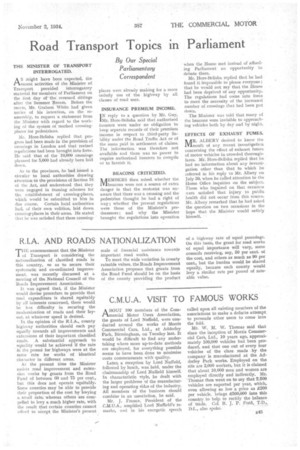R.I.A. AND ROADS NATIONALIZATION
Page 63

If you've noticed an error in this article please click here to report it so we can fix it.
TliE announcement that the Minister of Transport is considering the nationalization of classified roads in this country, so as to secure their systematic and co-ordinated improvement, was recently discussed at a meeting of the National Council of the Roads Improvement Association.
it was agreed that, if the Minister would devise procedure to provide that road expenditure is shared equitably by all interests concerned, there would be less difficulty in securing the modernization of roads and their layout, at whatever speed is desired.
In the opinion of the R.I.A, county highway authorities should each pay equally towards all improvements and extensions of their important classified roads. A substantial approach to eqUality would be achieved if the rate in the pound for highways were at the same rate for works of identical character in different areas.
At the present time the Minister assisis road improvement and extension works by grants from the Road Fund of between 60 and 75 per cent., but this does not operate equitably. Some counties may be able to provide their proportion of the cost by levying a. small rate; whereas others are compelled to levy a much higher rate, with the result that certain counties cannot afford to accept the Minister's present
scale of financial assistance towards important road works.
To meet the wide variation in county rateable values, the Roads Improvement Association proposes that grants from the Road Fund should be on the basis of the county providing the product
of a highway rate of equal poundage. On this basis, the grant for road works of equal importance will vary, some councils receiving, say, 50 per cent. of the cost, and others as much as 90 per cent., but the burden would be shared equally, because each county would levy a similar rate per pound of rateable value.




































































































